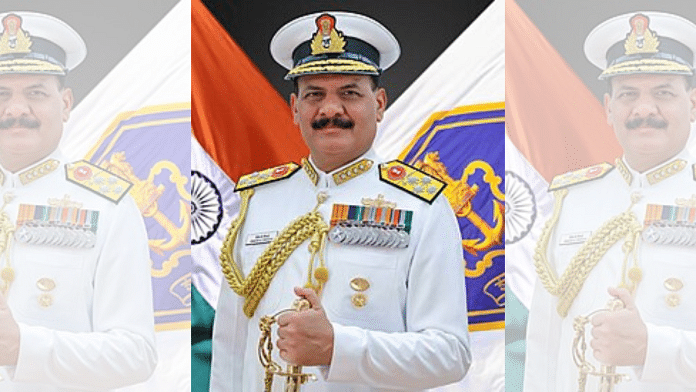New Delhi: Admiral Dinesh K. Tripathi, a communication and electronic warfare specialist, took over as the 26th chief of the naval staff Tuesday following the superannuation of his predecessor, Admiral R. Hari Kumar.
Admiral Tripathi told the media that “existing and emerging challenges” in the maritime domain mandated that the Navy remain operationally ready to deter potential adversities at sea in peace and to win wars at sea when asked to do so.
“That will remain my singular focus and endeavour,” he added, speaking after inspecting a guard of honour on the South Block lawns in the capital.
An alumnus of the National Defence Academy, Khadakwasla, Admiral Tripathi was commissioned on 1 July, 1985 into the Executive Branch of the Navy.
Among the key roles he has played in the Navy, Admiral Tripathi has been the director of naval Operations, principal director network centric operations and principal director naval plans at New Delhi.
On promotion to the rank of rear admiral, he served as assistant chief of naval staff (Policy and Plans).
His appointment comes at a time when naval warfare is seeing drastic changes, as in the Russia-Ukraine war where large destroyers worth billions of dollars are falling to cheap underwater drones — bringing into question the effectiveness of the large capital-intensive goliaths of the past.
While modern navies across the world have traditionally fought against regular forces, they are now being engaged by small, rebel organisations like the Houthis who have disrupted global maritime commerce with their missiles.
Amid all this, China’s navy has emerged as the world’s largest, leaving behind even the US in terms of active ships and those under construction.
The Indian Navy has also cut down on its long-term plan to be a 200-vessel-strong navy by 2027, having reduced this to a target 170 now .
Missiles, torpedos, helicopters need focus too
Sources in the defence and security establishment told ThePrint that while the focus has always been on big ships, it’s also important for the Navy to have other elements in place.
“The helicopter fleet of the Navy is left wanting. The modernisation plans of its helicopter fleet are left hanging. One has to really take stock of the number of missiles, torpedos and other combat elements that the Navy has in its inventory. While the focus is on new surface ships and submarines, these issues linger,” a source said.
Taking the big picture, another source said the big challenge before the Navy chief would be to decide the trajectory he wants the force to take.
“The challenge before the world is a more aggressive China, and any conflict with China will not be on land or air but in sea. And that is why the western world and Asian countries like Japan are investing in their navies,” a source said, explaining the importance of naval warfare in any future global conflict.
Sources said the big question before the Navy was to decide whether it wanted to project its power in waters away from it or offer sea denial to its adversaries.
“The Navy and the government have to decide whether it wants to go in for new aircraft carriers or have more submarines, both conventional and nuclear, along with long-range weapon systems. The submarine fleet of the Navy is an arm that is not receiving much attention and if urgent steps are not taken, the coming years will see severe shortfalls in this area,” a second source said.
India’s failing sub strength
India currently operates 16 conventional submarines, including five Scorpene-class (French), four HDWs (German) and seven Kilo-class (Russian). An additional Scorpene-class is still to be commissioned.
India will eventually operate 17 conventional submarines next year, but sources said that this would only be on paper.
This is because while availability of the Scorpene submarines is high because they are brand new, the Kilo will see problems despite having undergone upgrades.
India had 10 Kilo-class submarines initially but is now left with only seven.
While the HDWs are expected to last another 15 years, sources said the same cannot be said about the Kilos because most of them were commissioned in the 1980s and one has already been decommissioned.
The second one was refitted and given to Myanmar. The third was actually new, but India lost it in 2013 in an accident.
Also read: What is ‘ROCKS’, India’s first air-launched quasi-ballistic missile
‘Aircraft carriers majestic but a luxury’
“Aircraft carriers are a luxury and very capital intensive. Aircraft carriers operate with fighter jets on them and as a battle group. It looks majestic and is a show of strength but is a luxury item. Carriers make sense only for countries that are operating kilometres away from their own waters. India is focused on the Indian Ocean region,” a third source said.
The source explained that other ships sailing with aircraft carriers are for logistics and to provide the carrier with defence against enemy missiles and firepower.
“The Chinese have developed missiles meant to take down American aircraft carriers which are over one lakh tonnes displacement while the two that India operates are just 45,000 tonnes displacement,” the third source said.
Sources said the big focus area of the Navy chief would be to integrate more technology like unmanned systems and developing strategies to protect its assets against modern threats while countering them effectively.
(Edited by Tikli Basu)
Also read: Indian Navy conducts 2nd successful anti-piracy operation in 24 hours, 19 Pakistani crew saved



